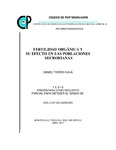Fertilidad orgánica y su efecto en las poblaciones microbianas.
Abstract
Las propiedades físicas y químicas del suelo, así como la diversidad de bacterias cultivables fueron evaluadas en los sistemas de producción orgánica y convencional de fresa, en Tapalpa, Jalisco, México. Las propiedades físicas del suelo del sistema orgánico presentaron una mejor agregación, densidad aparente y curva de retención de humedad. En ambos sistemas el suelo no mostró diferencias significativas en el contenido de nitrógeno. Sin embargo, el contenido de P del suelo del sistema orgánico fue de 0.15 meq L-1, mientras que el del sistema convencional fue de 0.6 meq L-1. El contenido de K fue más alto en el suelo del sistema convencional (71.9 meq L-1) que en el orgánico (25.2 meq L-1). A pesar de que en ambos sistemas se usa regularmente composta e inoculante microbiano comercial Mayamagic®, el suelo del sistema orgánico presentó mayor diversidad bacteriana (H´=2.53) que el del convencional (H´=1.43). Las bacterias Gram positivas predominaron en el sistema convencional. En el sistema orgánico se encontró similar cantidad de bacterias Gram positivas y Gram negativas. Los géneros presentes en ambos sistemas de producción fueron Bacillus, Pseudomonas y Acinetobacter. Bacillus fue el género que predominó en los sistemas convencional y orgánico con 24 y 14 especies, respectivamente. Las bacterias del sistema orgánico usaron preferentemente glucosa como fuente de C, a diferencia de las bacterias del sistema convencional. Así mismo, las bacterias del sistema orgánico emplearon carbohidratos de tipo monosacárido. Se concluye que los suelos bajo prácticas orgánicas presentaron una mayor porosidad y retención de humedad junto con una mejor agregación así mismo mayores niveles de nutrientes, como el P, Mg y S, además de una mayor diversidad bacteriana que los suelos bajo manejo convencional. _______________ ORGANIC FERTILITY AND ITS EFFECT ON MICROBIAL POPULATIONS. ABSTRACT: The physical and chemical properties of the soil, as well as the diversity of cultivable bacteria, were evaluated in organic and conventional strawberry production systems, in Tapalpa, Jalisco, Mexico. The soil physical properties of the organic system showed a better aggregation, bulk density and moisture retention curve. In both systems, the soil did not show significant differences in nitrogen content. The content of K was higher in the soil of the conventional system (71.9 meq L-1) than in the organic soil (25.2 meq L-1). Although both systems regularly use compost and Mayamagic® commercial microbial inoculant, the soil of the organic system presented greater bacterial diversity (H'= 2.53) than the conventional one (H'= 1.43). Gram positive bacteria predominated in the conventional system. In the organic system, a similar amount of Gram positive and Gram negative bacteria was found. The genera present in both production systems were Bacillus, Pseudomonas and Acinetobacter. Bacillus was the genus that predominated in conventional and organic systems with 24 and 14 species, respectively. The bacteria of the organic system preferably used glucose as C source, unlike the bacteria of the conventional system. Likewise, the bacteria of the organic system used monosaccharide type carbohydrates. It is concluded that the soils under organic practices presented a higher porosity and moisture retention along with a better aggregation as well as higher levels of nutrients, such as P, Mg and S, in addition to a greater bacterial diversity than the soils under conventional management.
Collections
- Tesis MC, MT, MP y DC [349]
The following license files are associated with this item:


